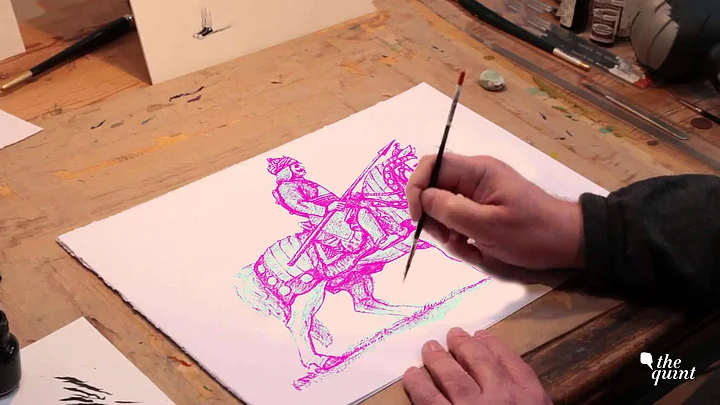(This story was first published on 8 May 2018. It has been reposted from The Quint’s archives on the birth anniversary of Maharana Pratap)
Haldighati – a narrow pass of great strategic significance – marks the site of a famous battle. This is where Maharana Pratap lost a battle and was forced to retreat from the majestic Kumbhalgarh fort into the jungles of Aravali to live and fight another day.
This saga of heroism has inspired generations of Indians, including freedom fighters against the British in the 20th century. Till few months back, there was no dispute about who had won and who had lost at Haldighati. It was the invading armies sent by Akbar to subdue Mewar who had succeeded.
Now we are being told that this is not what happened. It was Maharana Pratap who made the Mughal armies to retreat. He was the real victor who has been denied his prize by historians, even the much maligned Nationalist historians.
We live in difficult times. Mythology has ceased to be a metaphor, it is used to challenge science, and legend and lore carry more weight than history.
It is necessary to examine the latest historical controversy dispassionately, and in the larger socio-political context.
Rana Pratap’s Heroic Stature Needs No Validation
Maharana Pratap has always been mentioned in school history textbooks as an iconic and inspirational figure – a symbol of invincible courage, indomitable spirit, a chivalrous Rajput ruler who befriended the tribal Bhils and despite the loss suffered at the Battle of Haldighati, never accepted defeat and continued his fight against the Mughal emperor for years, bearing adversity with great fortitude.
His image has always been larger than life. The guerrilla warfare he waged to harass the Mughals was later adopted by Shivaji. His armour on display in a museum in Rajasthan makes us wonder how difficult it must have been to prance around the battlefield clad in so heavy a battle dress!
Legend has it that he laid low opponents riding an elephant with his lance that never missed. Even his stallion Chetak has inspired stirring poems in Hindi.
Rana Pratap was a scion of the Sisodiya clan of Mewar, that with some justification claims to be longest ruling dynasty in India. He belonged to a line that has many illustrious names like Hammir Dev and Rana Kumbha.
In brief, his memory is hallowed and doesn’t require the crutches of ‘alternative facts’ or ‘imagined reality’ to prove his heroic stature or exceptional patriotism.
Rajasthan Textbook Controversy Serves Nothing But Petty Political Interests
It is in this context that the manufactured controversy (initiated by rewriting this chapter in Rajasthan School Textbooks) leaves a bitter taste in the mouth. It is almost like committing sacrilege by bringing him down from a pedestal to serve petty political interests.
Rana may have lost the battle at Haldighati but emerged the real victor.
Too busy to read? Listen to it instead.
As soon as Akbar was distracted by the campaign in Gujarat, Rana slowly gnawed back and regained most of the lost territories. Although he failed to regain the citadel of Chittorgarh, he expelled the Mughal soldiers garrisoned at Kumbalgarh, and not long after Haldighati, inflicted a defeat on a large continent of Mughal soldiers.
Led by him, the marauding bands of Bhils continued to maul the invaders from Delhi and their Rajput collaborators. Raja Mansingh is listed among one of the Nine Gems at Akbar’s court, but no one remembers him with pride or affection.
Its Rana Pratap who shines like a Sun with his glory undiminished across centuries.
There is no need to present Rana Pratap and Akbar as binaries. The battle of Haldighati was not fought between Hindus and Muslims.
It is inane and extremely dangerous to hold back that distant mirror to present a distorted reflection of present divisive ‘reality’. Honesty demands that we admit that Akbar’s sack of Chittor was no less brutal than that inflicted by Allauddin Khilji.
Historians sympathetic to Mugal-e-Azam have been constrained to admit this blemish on his record as a humane, compassionate and tolerant ruler.
Similarly it is grossly unfair to portray Rana Pratap solely as a symbol of Rajput chivalry and unmatched valour representative of feudal mindset.
What purpose is served by dwarfing him just to capture a vote bank?
Porus, as is well known, lost to Alexander the Great, but continues to be remembered as the person who finally emerged victorious with his honour intact.
His verbal exchange with the Macedonian conquerer has immortalised him – “Treat me like a king treats another!” There is a valuable lesson to be learnt here. It is not important to win all battles.
What matters is how a hero lives on in the memory of his people.
Maharana Pratap doesn’t deserve fabricated victories substantiated by dubious evidence.
(Padma Shri awardee Professor Pushpesh Pant is a noted Indian academic, food critic and historian. He tweets @PushpeshPant. This is an opinion piece. The views expressed are the author’s own. The Quint neither endorses nor is responsible for them.)
(At The Quint, we question everything. Play an active role in shaping our journalism by becoming a member today.)
